-
Basement Waterproofing Do’s and Don’ts
Basement Waterproofing Do’s and Don’ts
Describing a wet basement as unpleasant is an understatement. A wet, leaky and musty or even a flooded basement is basically one of the worst nightmares to deal with for a homeowner – especially during cold winter months. Not only is it annoying to step into a leaky basement, but it can be hazardous to your health.
The good news is that a smart homeowner who knows the risks associated with a flooded or wet basement, will take the proper steps to ensure the basement stays dry and warm year round.
All houses are not created equal, therefore as a homeowner you are responsible for assessing your home and the surrounding area so you can figure out whether your basement is in danger of flooding.
Honestly, all basements are susceptible to flooding and this isn’t because a basement was poorly built. Simply put, when water accumulates outside of the home’s foundation it keeps putting pressure on the concrete – this is called hydrostatic pressure. One day, after all the pushing, the concrete will give up and crack, which is when water happily rushes in to flood your basement and ruin your furniture.
The key to keeping your basement dry is good waterproofing and proper drainage. The whole system consists of many parts that work together including gutters, downspouts, the slope of the ground around the foundation, sump pumps and more. It’s important to do your homework when investing in waterproofing so you can make sure that you are investing in the right solution for your home.
Let’s review some simple basement waterproofing do’s and don’ts .
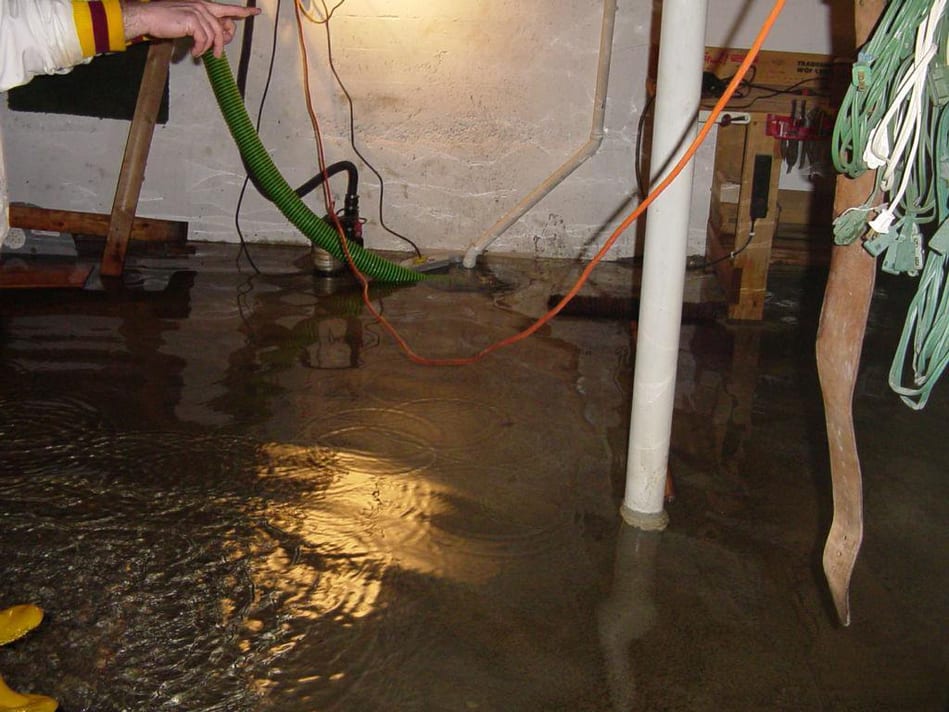
DO research different methods of waterproofing
There are three main methods of basement waterproofing and these are interior sealants, exterior waterproofing and drainage. Since each situation, home and basement is different there are different solutions for different issues. A coat or two of a waterproof sealant may be enough for some homes, while others may need to install a French drain, a sump pump and waterproof sealing.
DON’T use DIY sealants
The easiest fixes are always temporary. If you visit a home improvement store you will find many options for waterproof methods and sealants boasting to be the best on the market. You will be bombarded with advertising trying to convince you that so and so product is the best and will fix every leaky basement. This is simply not true. We really can’t stress enough that not every wet basement is the same. If you find a small leak and you want to cover it up with a temporary sealant while you concoct a serious plan of action, that’s fine as long as you understand that this is only temporary and the leak will come back.
DO find the source of the leak
The best way to fix a leaky basement is to find the source of the water and cut it off. Is the water seeping in through the ground? It is coming in through a window? Is it the foundation of the home? This is the most important step of waterproofing, because unless you cut off the source of the leak and fix it, it will keep coming back.
DON’T ignore a leak
The worse thing you can do for your home, your basement and the overall foundation and structure of your home is to ignore a leak. It may seem small and insignificant, but that small crack or leak will get bigger and then you will have an even more serious problem to deal with. Being cheap won’t get you far, it’s better to invest a little bit of money and take care of a problem before it gets worse and you end up having to pay a lot more for damage control. Did you even know that basement waterproofing can save you money in the long run? It can reduce energy costs, save you money on your homeowner’s insurance as well as increase the overall value of your home.
DO keep your gutters clean
Who would have thought that clogged gutters could ultimately lead to a flooded basement? Imagine a backed up rain gutter suddenly letting loose and dumping all that water against the foundation of your home. Keep your gutters clean and free from debris and leaves so that the collected water can easily make its way to the downspouts and away from your home.
DON’T allow your downspouts to direct water around the foundation of your home
Speaking of downspouts, the whole point of having them is to make sure they keep water away from your home. If your downspout is just shooting water against the foundation of your home it’s more likely to cause a problem than fix it.
DO call Triad Basement Waterproofing for assistance
When in doubt, work with a professional company that specializes in all kinds of basement services. Our staff of experts will evaluate your basement and help you figure out what your basement needs to stay dry year round. Maybe you don’t need any waterproofing at all, you’ll never know until you ask. Triad has been around for more than 27 years and our team prides itself on a job well done every time. Give us a call if you have any questions about basement waterproofing , concrete repair or other basement related questions. We look forward to working with you!
-
Buying a Home with a Wet Basement? Know This First
Buying a Home with a Wet Basement? Know This First
When you buy a new home you are paying for all the good as well as all of the bad that comes with it.
It’s very important to thoroughly inspect a property with professional multiple times over before you sign any contracts so you can make sure that there aren’t any hidden problems that will creep up down the road.
However, if you find a home that you absolutely love and can’t part with and it has structural or basement issues then you need to educate yourself on what steps you need to take to protect your new home and your belongings.
Before you buy a home with a wet basement make sure to ask the seller of the home about any underlying issues that may be causing leaks and moisture seepage. The seller should fully disclose all information about the home and you should also hire a qualified home inspector to give you a full report about the home.
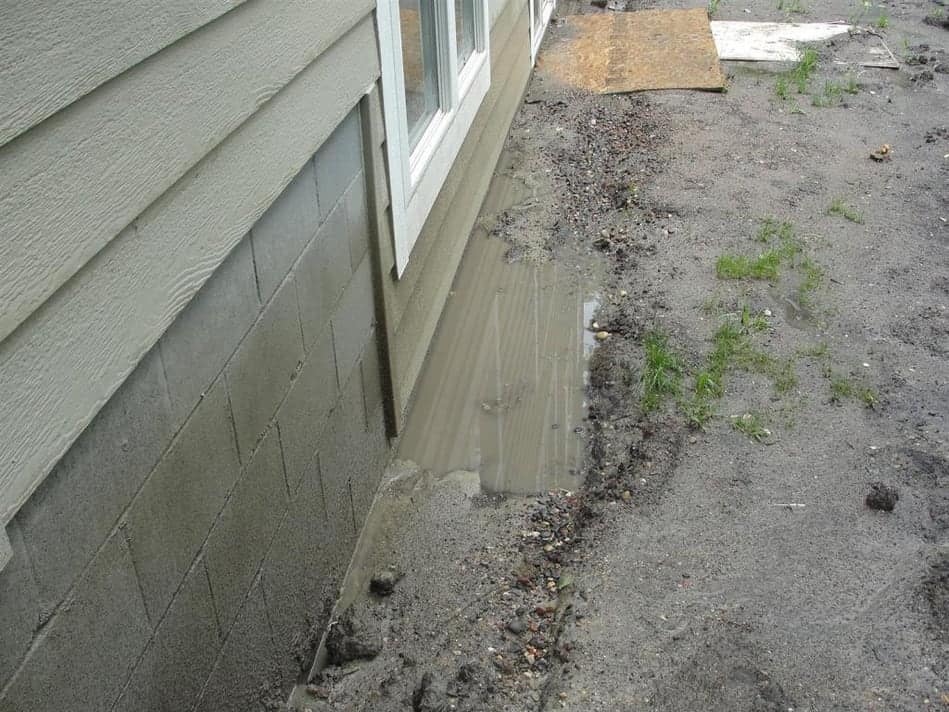
Does Your New Home to-be Have a Wet Basement?
We’ve discussed how to prevent a wet basement and how to fix a basement after it has been flooded, but we have yet to touch on inheriting a basement that has issues with leaking or flooding.
The most important thing to remember is that if there are dampness issues with your new basement, you really can’t afford to let them linger. There are many dangers of wet basements such as deteriorating the overall structure and foundation of your home, contributing to hazardous mold growth, damaging your furniture and personal belongings and other unpleasant issues. These issues can ultimately affect air quality and your health.
Regardless of what you will be using the basement for whether it’s going to be storage space, a guest room or entertainment center it is still a room in your home and as a responsible homeowner you need to take care of it. So what should you do when buying a home with a wet basement? Let’s find out.
Find out what is causing the dampness
In order to figure out why your new basement is leaky or damp, you need to find the source of the moisture. There are many ways that water can find its way into your home. Through windows, wall cracks, through the floor or in the seams between the wall and the floor are most common entry points. Water can’t force its way into your home, so it takes the path of least resistance and looks for a weak spot in your foundation. The underlying cause of a leaky basement is hydrostatic pressure. Water builds up in the soil outside your basement walls and eventually when the concrete can’t hold its own anymore it begins to crack, which allows water to enter into your basement.
Learn about how a wet basement can affect your home and your health
You may think that a wet basement isn’t a big deal. Most people who have never had a home with a basement before assume that it’s leaky and cold down there anyway. Before you commit to buying a home with a wet basement you need to understand how a wet basement will affect your home and the health of you and your family. Humid and damp spaces are breeding grounds for dangerous mold growth. Not to mention that if there is a leak and it’s not taken care of as soon as possible, it will damage the foundation of the home, which in turn can lead to serious structural issues.
Invest in basement waterproofing
If you are dead set on purchasing a home with a wet basement make sure to invest in basement waterproofing. Before you close escrow you could also negotiate with the seller of the property to lower the purchase price of the home or get a credit to fix the leaky basement. It’s better to be safe than sorry and take all precautionary measures to ensure your basement and your homestay dry and warm. There are different methods of basement waterproofing that will help protect your home from leaks and floods. Each home and each basement is different so one solution may work for you while another won’t. This is also why it is important to consult with a professional waterproofing company. While many people decide to try the do-it-yourself option, it’s always safer to hire a professional, especially if you have never dealt with a wet basement before.
Triad Basement Waterproofing has more than 27 years of experience and the professional staff guarantees a personalized solution for each basement as well as a job well done every single time. If you are looking for a dedicated and experienced company to help you fix and secure the wet basement of your new home, contact Triad today. The staff will be more than happy to answer all of your questions and evaluate your basement.
-
Is Interior Waterproofing Different from Exterior Waterproofing?
Is Interior Waterproofing Different from Exterior Waterproofing?
At Triad Basement Waterproofing, we know that managing moisture and preventing water damage is key to maintaining the structural integrity of a building. In areas prone to heavy rain or where basements are below the water table, waterproofing can be especially important. Our professionals have been helping to repair and protect homes from water intrusion and damage since 1987, and today we want to help you learn more about the processes involved in waterproofing. Generally, we can divide the procedure into two categories: interior and exterior. Each method addresses different issues and offers unique benefits and challenges. Today, we will explore both methods in detail, outlining their pros and cons, and distinguish between the two to help you make informed decisions.
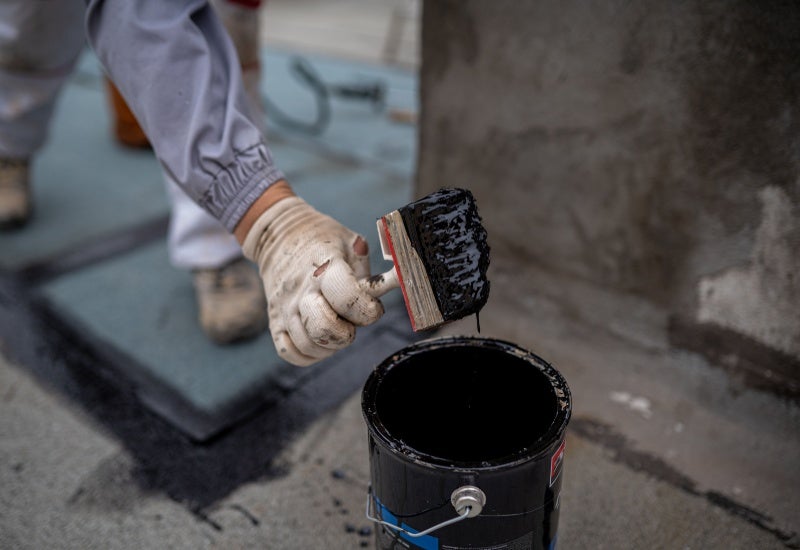
Identifying the Problems of Basement Leak
Basement leaks can be a homeowner’s nightmare, leading to costly repairs and significant damage if not addressed properly. Common signs of basement leaks include water stains on walls and floors, musty odors, peeling paint or wallpaper, and accumulation of mold and mildew. These issues typically arise from hydrostatic pressure, which forces water through cracks in the foundation, improper drainage, or issues with the building’s construction material. Identifying the root cause of the leak is the first step towards choosing the appropriate waterproofing method.
What Is Interior Waterproofing?
Interior waterproofing involves addressing water issues from inside the basement or foundation walls. This method typically includes the installation of drain tile systems around the perimeter of the floor, a sump pump to remove water, and the application of sealants on the walls and floor. These techniques are designed to manage water that has entered the building, redirecting it away from the basement and foundation structures.
Pros & Cons of Interior Waterproofing
Pros:
- Cost-effective: Generally less expensive than exterior waterproofing as it involves less labor-intensive excavation work.
- Less intrusive: Does not require extensive landscaping or external alterations to your home.
- Quick installation: Can often be completed in less time than exterior waterproofing.
Cons:
- Reactive approach: Primarily deals with water after it has entered the structure, which can sometimes allow for moisture-related issues to persist.
- Maintenance required: Systems like sump pumps require regular maintenance and electricity to operate.
What Is Exterior Waterproofing?
Exterior waterproofing aims to prevent water from entering the home by treating the exterior walls of the basement or foundation. This method often involves excavating around the house to the full depth of the foundation walls, then applying a waterproof coating or membrane to the exterior walls and installing drainage solutions like a French drain system around the perimeter.
Pros & Cons of Exterior Waterproofing
Pros:
- Proactive solution: Prevents water from entering the structure, addressing the issue before it can cause internal damage.
- Long-term solution: Tends to last longer with less maintenance since it deals directly with external moisture.
- Increases property value: Enhances the overall health of the building structure, potentially raising property value.
Cons:
- High cost: More labor and material intensive, leading to higher costs.
- Disruptive: Requires significant excavation, which can disturb landscaping and take longer to complete.
What is the Difference Between Interior and Exterior Waterproofing Methods?
The key difference between interior and exterior waterproofing lies in their approach and the extent of their application. Interior waterproofing is designed to manage water that has already entered the building, making it a more reactive measure. In contrast, exterior waterproofing is a preventative approach, stopping water before it breaches the foundation walls.
Choosing between interior and exterior waterproofing depends on several factors, such as the severity of the water issue, the construction of the building, the local climate, and budget considerations. In some cases, a combination of both methods may be the most effective way to ensure a dry and healthy basement environment.Call Triad Basement Waterproofing
For over 30 years, Triad Basement Waterproofing has been solving moisture problems in basements across Washington D.C., Virginia, and Maryland. Our professionals are skilled at finding and fixing water leakage issues before they can grow large enough to cause problems with the structural integrity of your home. We have developed state-of-the-art solutions for basement water leakage and structural support. We also remove mold and mildew when it finds its way into your home and craft drainage solutions to make sure these issues don’t happen again. Call us now at (301) 532-7903 or visit our website at Triad Basement Waterproofing to schedule your free consultation.
-
What Causes Concrete Foundation Cracks?
What Causes Concrete Foundation Cracks?
Although our homes are built to be resilient to many things, after some time they tend to wear down. In the same way we show signs of age through wrinkles, our homes show it through imperfections and cracks. With the flaws of imperfect construction, pressure surrounding the home and the weight of the house bearing down on it, the foundation of your home takes it all. When it comes to foundation cracks or repairs, the important thing is to take care of the issue as soon as possible. It’s not a good idea to forget about it and wait until the crack gets bigger and allows water to leak into your basement and flood your home.
All concrete has the tendency to crack and there is no way to produce crack-free concrete. Concrete expands and shrinks with changes in temperature and moisture and this can cause cracking early on. Often concrete foundation cracks are not detected until long after they’ve formed. Regardless of how long the crack has been there, it tends to concern homeowners and they worry about the imperfection.
Cracks in concrete foundation most often appear at weak points like corners, basement window frames, walls and pipe areas. It’s important to keep track of these cracks and notice if they are getting bigger. It’s also important to understand why the crack showed up in the first place. What causes concrete foundation cracks? Read on to find out!
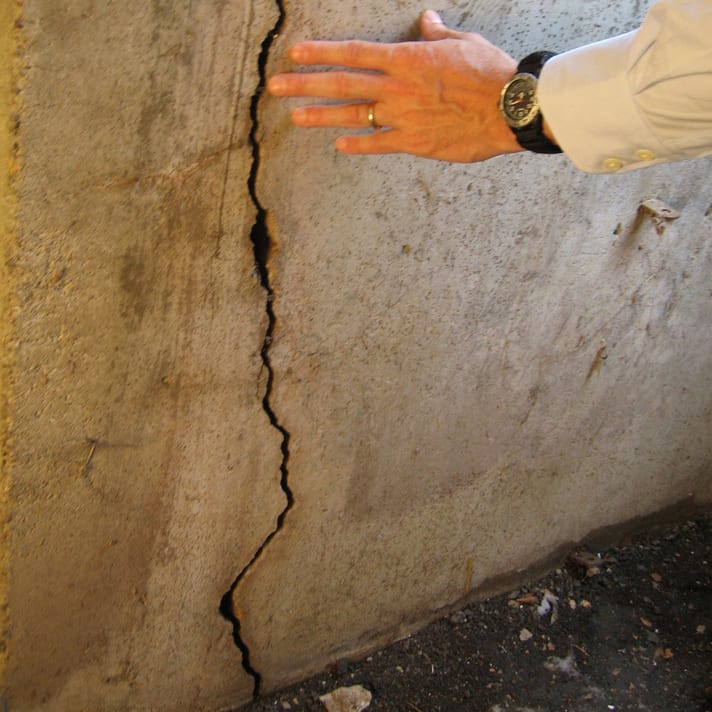
Top Causes of Concrete Foundation Cracks
Drought or too much moisture
Soil shrinks like a sponge when moisture is removed from it and when that happens it pulls away from the foundation of your home creating a gap. This gap allows for the foundation to move. When the foundation of a home is not supported properly it can shift around and cracks will begin to appear. In turn, if there is too much moisture it will cause the soil that is supporting the foundation of your home to expand.
Earthquakes
When an earthquake occurs it causes the ground to shake, which in turn shakes your home around. Thankfully not too many earthquakes occur on this side of the U.S., however even the tiniest of quivers can be an issue. Remember, if the foundation isn’t supported or stable, it can move around, weaken and crack. A small earthquake may not cause new cracks, but it can intensify ones that are already present.
Storms
Whether you experience a hurricane, a nor’easter or just a typical rainstorm these storms produce a lot of water, which can damage the foundation of your home. Too much water will force the soil around the foundation of your home to expand, which will push up against the home and cause concrete foundation cracks. Storms can also cause various other structural problems if you don’t take preventive measures to secure your home. One of the most popular explanations behind concrete foundation cracks is the freeze and thaw cycle during the winter. Concrete freezes at around 18 degrees and then it melts at around 35 degrees, which is when the cracking develops.
Plumbing Leaks
It’s important to make sure your pipes are secured and aren’t leaking and that you don’t have any plumbing leaks in your home. If you’re home isn’t equipped with basement waterproofing or a sump pump, the excess water will add to the soil causing it to expand and push against your foundation.
Flooding
Regardless of whether the flooding comes from a storm, a leak, inadequate drainage or something else, too much water will be a problem for your concrete foundation. When hydrostatic pressure becomes too much for the foundation of your home you will notice more leaks, more cracks and more problems.
Extreme Heat
Concrete can also crack under extreme sun and heat because it causes the concrete to expand. During the day and under the sun the concrete will expand, and then overnight the concrete will shrink and retreat back to its original unbaked position.
Get Help Fixing Your Cracks
The moral of the story is that it is important to keep your foundation stable, dry and supported.
When your foundation has wiggle room due to dry soil or if it’s tightly pushed in by expanding soil, these movements cause it to weaken and in turn create concrete foundation cracks. The good news is that concrete foundation cracks that are a result of too much moisture and flooding can be prevented through various methods of basement waterproofing.
It’s also not too difficult to repair concrete foundation cracks with epoxy injections. If you are thinking about preventive measures or you need concrete repair, then contact the team at Triad Basement Waterproofing and they will create a custom solution to your specific situation.
-
Top 3 Methods of Basement Waterproofing
Top 3 Methods of Basement Waterproofing
A dry basement is not only essential for the structural integrity of your home, but also for maintaining a healthy living environment. Basement waterproofing is a key step in protecting your property from moisture related issues. Triad Basement Waterproofing offers comprehensive solutions to keep your basement dry and safe.
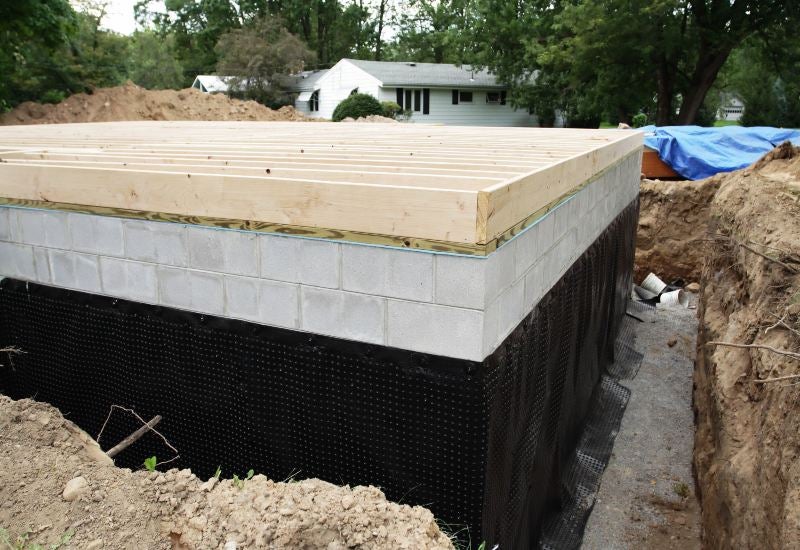
Causes of Moisture in the Basement
Before discussing the methods of basement waterproofing, it’s important to understand the common causes of basement moisture. Water can infiltrate your basement through various means, including:
- Groundwater Seepage – Water from the surrounding soil can seep through the basement walls and floor due to hydrostatic pressure. This pressure builds up when the soil around your home becomes saturated, pushing water through any available gaps or cracks.
- Surface Water Infiltration – Improperly graded landscapes can cause rainwater or melting snow to flow toward your foundation, leading to leaks. This often occurs when the ground slopes toward the house instead of away from it, allowing water to pool around the foundation.
- Plumbing Leaks – Faulty plumbing systems can introduce unwanted moisture into your basement. Leaky pipes, water heaters, or fixtures can cause continuous moisture problems if not addressed promptly.
- Condensation – High humidity levels in the basement can result in condensation, creating damp conditions. This often happens in basements with poor ventilation, where warm, moist air meets cooler surfaces.
Understanding these causes helps in choosing the right waterproofing method tailored to your specific needs.
Basement Waterproofing Methods
There are several effective methods to waterproof your basement, each catering to different causes and severities of moisture problems. Here are the top 3 methods:
-
Interior Basement Waterproofing
Interior basement waterproofing focuses on managing water that enters your basement. This method typically involves installing a drainage system that directs water to a sump pump, which then expels the water out of your basement. Key components of interior waterproofing include:
- French Drains – These are perforated pipes installed along the perimeter of the basement floor, channeling water to the sump pump.
- Sump Pumps – These devices are essential for pumping out the collected water to keep your basement dry.
- Vapor Barriers – These barriers are installed on basement walls to prevent moisture from seeping through.
-
Exterior Basement Waterproofing
Exterior basement waterproofing addresses water issues from the outside before they can penetrate the basement walls. This method is considered highly effective as it prevents water from entering your home altogether. Key components of exterior waterproofing include:
- Excavation – This process involves digging around the foundation to apply waterproofing materials directly to the exterior walls.
- Membranes – Waterproof membranes are applied to the foundation walls to create a water-resistant barrier.
- Drainage Systems – Installing exterior drainage systems, such as footing drains, helps divert water away from the foundation.
-
Interior Sealants
Interior sealants are used to seal cracks and gaps in basement walls and floors to prevent moisture ingress. This method is suitable for minor leaks and can be a quick and cost-effective solution. Key components of interior sealants include:
- Epoxy Injections – These are used to fill cracks in the walls, providing a strong and durable seal.
- Silicone-Based Sealants – These sealants are applied to joints and gaps to block moisture entry.
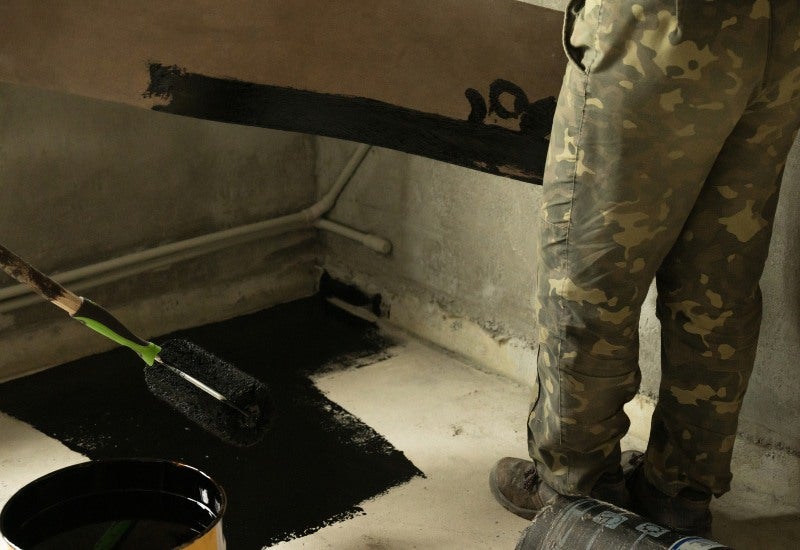
Advantages of Basement Waterproofing
Basement waterproofing offers numerous benefits that go beyond just keeping your basement dry:
-
-
- Enhanced Structural Integrity –Waterproofing helps prevent water damage that could weaken the foundation and structure of your home. By stopping water infiltration, you reduce the risk of foundation cracks and shifting.
- Improved Air Quality – By keeping moisture out, waterproofing reduces the risk of mold and mildew growth, promoting healthier indoor air quality. This is especially important for families with allergies or respiratory issues.
- Increased Property Value – A dry, well-maintained basement can add to the overall value of your home. Potential buyers often view a waterproof basement as a sign of proper home maintenance and care.
- Additional Living Space—Waterproofing allows you to utilize your basement as a functional and comfortable living area. Whether you want to create a home gym, office, or an additional bedroom, a dry basement provides the perfect foundation for your plans.
-
By understanding the causes of basement moisture and implementing the right waterproofing methods, you can safeguard your home effectively. Triad Basement Waterproofing is here to help you every step of the way, offering professional solutions tailored to your specific requirements. Protect your home today and enjoy a dry, safe basement for years to come.
Choose Triad Basement Waterproofing in Gaithersburg, MD
Triad Basement Waterproofing in Gaithersburg, MD, is your trusted partner in basement waterproofing solutions. With years of experience and a commitment to quality, our team provides reliable services to protect your home from moisture-related issues. We offer a comprehensive range of services, from interior and exterior waterproofing to expert advice on maintaining a dry basement.
Contact us today to schedule a consultation and learn more about how we can help keep your basement dry and secure. Visit our website at Triad Basement Waterproofing to explore our services and discover why homeowners in Gaithersburg trust us for their waterproofing needs.
-
How to Prevent a Flooded Basement in the Winter
How to Prevent a Flooded Basement in the Winter
Winter is upon us and that means that it is very important to protect our basements from any flooding this year. Heavy snow, heavy rain and in turn heavy snowmelts are extremely threatening to unprotected basements. Many people believe that the rainy season is the worst time of year for a basement. While heavy rain does pose a high threat to unprotected basements, winter and snow can be worse.
When the temperature of the ground is above freezing the accumulated snow instantly melts and turns into water, which has the same effect as rain. If the temperature of the ground is below freezing, snow will accumulate and as soon as the temperature rises it can turn into a heavy stream of water pounding against the foundation of your home. When water accumulates around your home, the water can seep through any porous surfaces, cracks in the foundation, window wells, etc.
You know how a quick change in temperature from cold to hot can crack glass?
Big temperature changes can do the same thing to your foundation, weakening it over time and allowing water to flow freely into your basement. The last thing you want to do is walk into a flooded basement during the cold winter months! Don’t wait till winter to invest in basement waterproofing, the colder weather makes it tough to work outside, so it is important to take care of the work before the temperatures drop.
Here are some tips from the professionals at Triad Basement Waterproofing that will show you how to prevent a flooded basement in the winter.
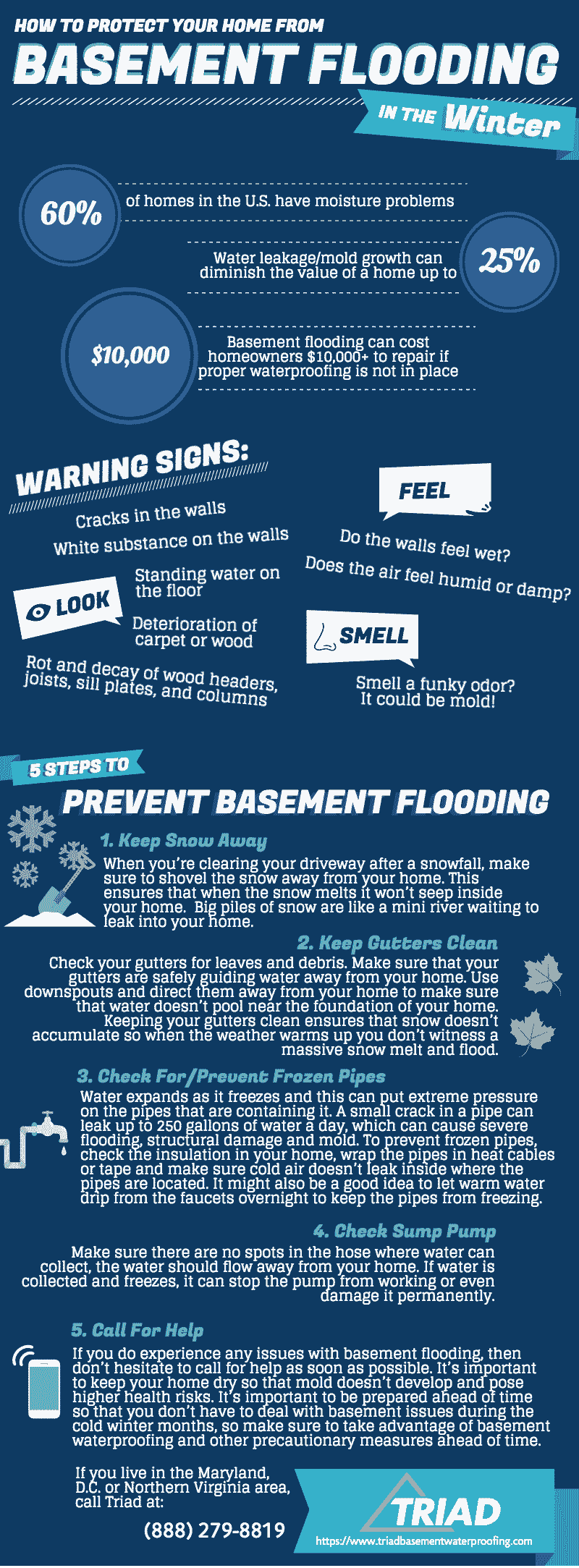
- Keep Snow Away From Your Home
When you’re clearing your driveway after a snowfall, make sure to shovel the snow away from your home. This ensures that when the snow melts it won’t seep inside your home. Big piles of snow are like a mini river waiting to leak into your home.
- Keep Your Gutters Clean
Keeping your gutters clean is something you should be doing throughout the year anyway. Before winter comes around check your gutters for leaves and debris. Make sure that your gutters are safely guiding water away from your home. Use downspouts and direct them away from your home to make sure that water doesn’t pool near the foundation of your home. Keeping your gutters clean ensures that snow doesn’t accumulate so when the weather warms up you don’t witness a massive snow melt and flood.
- Check for & Prevent Frozen Pipes
Water expands as it freezes and this can put extreme pressure on the pipes that are containing it. Pipes that freeze often are those that are exposed to severe cold such as swimming pool supply lines, sprinklers, outdoor faucets and other pipes housed in unheated areas like the basement, garage or attic. A small crack in a pipe can leak up to 250 gallons of water a day, which can cause severe flooding, structural damage and mold. To prevent frozen pipes you can check the insulation in your home, wrap the pipes in heat cables or tape and make sure cold air doesn’t leak inside where the pipes are located. It might also be a good idea to let warm water drip from the faucets overnight to keep the pipes from freezing.
- Check Your Sump Pump
Double check your sump pump before winter rolls around. Make sure there are no spots in the hose where water can collect, the water should flow away from your home. If water is collected and freezes, it can stop the pump from working or even damage it permanently.
- Call for Help!
If you do experience any issues with basement flooding, then don’t hesitate to call for help as soon as possible. It’s important to keep your home dry so that mold doesn’t develop and pose higher health risks. It’s important to be prepared ahead of time so that you don’t have to deal with basement issues during the cold winter months, so make sure to take advantage of basement waterproofing and other precautionary measures ahead of time.
Coming home to find your basement flooded is never fun, but experiencing flooding during the cold winter months can be brutal. The winter season is supposed to be warm and cozy and there’s nothing like a flooded basement to ruin the whole experience for you and your family. It’s important to know what to look for and how to prevent a flooded basement in the winter. Triad Basement Waterproofing has more than 27 years of experience dealing with basement water problems and the experts here can help insure that your home stays dry at any given time of the year. Check out our website for a full list of services and contact us if you have any questions !
-
What is Concrete Resurfacing?
Concrete Resurfacing by Triad Basement Waterproofing
As a proud homeowner, you strive to care for your property, so it always looks and functions its best. As you assess the structures and features around your home and yard, one thing that might stick out is the old, cracked concrete. You may not be eager to pay for a replacement, but this eyesore is starting to wear on you.
That’s where concrete resurfacing comes in. This restoration technique revives worn or damaged concrete surfaces without completely replacing them. It’s a cost-effective solution that involves applying a thin layer of concrete overlay or coating to existing concrete, enhancing its appearance, durability, and functionality. Suitable for basements, driveways, patios, and sidewalks, concrete resurfacing offers a sustainable way to extend the lifespan and improve the appearance of concrete surfaces throughout your property.
Why is Concrete Resurfacing Necessary?
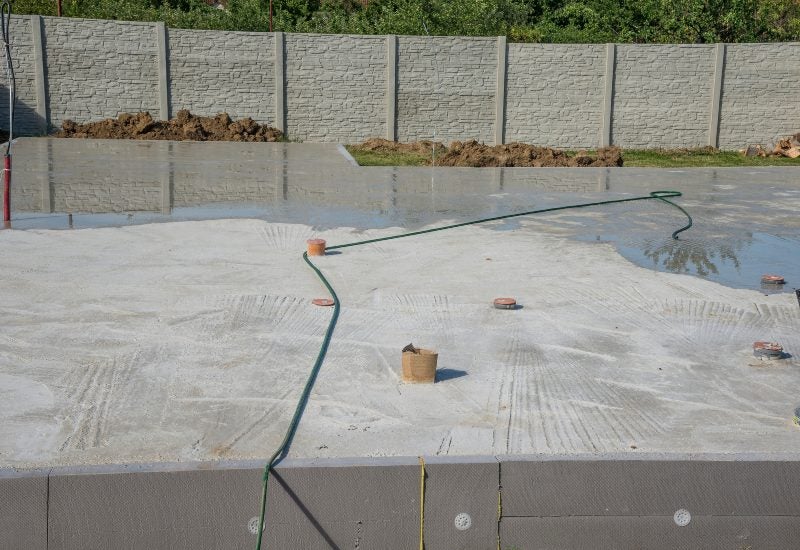
Concrete is subject to wear and tear over time due to foot traffic, weather, and other environmental factors, leading to cracks, stains, and a worn-out appearance. Concrete resurfacing solves these issues, providing a fresh top layer that makes the concrete look brand-new without the cost of a full replacement. You can even use this opportunity to customize the concrete’s color, texture, and pattern, creating the look of a completely new slab and improving your property’s aesthetics.
What is the Procedure for Concrete Resurfacing?
Whether you’re looking to resurface basement concrete or a concrete patio, the process is largely the same. Here are the key steps involved to ensure a successful application:
- Initial inspection and repair: The first step is to assess the concrete surface for any major damage. Repair cracks or holes larger than one-quarter inch deep or wide to ensure a smooth, structurally sound base for resurfacing.
- Cleaning: Thoroughly clean the surface using acid, detergent, or bleach, followed by pressure washing to remove any deteriorated concrete and ensure overlay adhesion.
- Preparation of the resurfacer: Mix the concrete resurfacer with water using a commercial-grade drill and mixer. A mechanical mortar mixer may be needed for later jobs. Follow the manufacturer’s instructions to achieve the correct consistency.
- Application: Apply the resurfacer in one-foot-wide strips using a long-handled squeegee. Work the product into the surface to ensure it penetrates the pores and achieves an even thickness.
- Finishing touches: After the resurfacer begins to set, use a broom to texture the surface for a non-slip finish if desired. Keep the surface moist for 24 to 48 hours to promote a strong bond and prevent shrinkage cracks.
What are the Advantages of Concrete Resurfacing?
Concrete floor or driveway resurfacing offers numerous benefits:
- Cost-effectiveness: Resurfacing eliminates the need to demolish and replace existing concrete, saving money on labor and materials.
- Quick turnaround time: The resurfacing process is much faster than laying new concrete, with areas often ready for traffic in just a few days.
- Customizable finishes: Even without a full replacement, you still have the flexibility to choose a new finish with coloring, stamping, or staining, making it easy to match any decor or landscaping theme.
- Durability: Resurfacing adds a strong top layer to the existing concrete, extending its lifespan and enhancing resistance to wear and tear.
- Low maintenance: The new surface requires minimal upkeep, saving time and money on future maintenance and repairs.
Does My Surface Qualify for Concrete Resurfacing?
Concrete resurfacing works best on areas with minor damage, so a thorough evaluation is required to determine if a surface is suitable for this restoration method. Excessive cracking is a concern because it might suggest deeper issues like ground movement, potentially causing the resurfaced layer to crack. Dusting and high moisture levels may also compromise the resurfacing process, leading to delamination or damage.
It’s important to note that resurfacing doesn’t solve structural problems, so replacing the concrete might be recommended in some cases. Even if your surface qualifies for concrete resurfacing, proper preparation and repair of large holes and pitting are essential for a successful finished product.
Contact Triad Basement Waterproofing in Gaithersburg, MD
At Triad Basement Waterproofing, we pride ourselves on delivering state-of-the-art, cost-effective concrete resurfacing and basement waterproofing solutions. Our local, family-owned business has been serving Gaithersburg, MD, since 1987. We are licensed, bonded, and insured professionals who provide the highest quality work with industry-leading warranties to back up everything we do. If you’re looking for concrete floor resurfacing inside or outside your home, please contact us at (301) 532-7903 to request a free estimate.
-
What to Do If Your Basement Floods
Solutions to Prevent Basement Flooding by Triad Basement Waterproofing
It’s raining pretty hard, so you decide to check on the basement. Discovering water pouring in from the window wells or slowing rising from the floor is shocking, but don’t panic. Prompt action is the best way to mitigate property damage and salvage your belongings. Here’s how to address basement flooding and prevent future water intrusion.
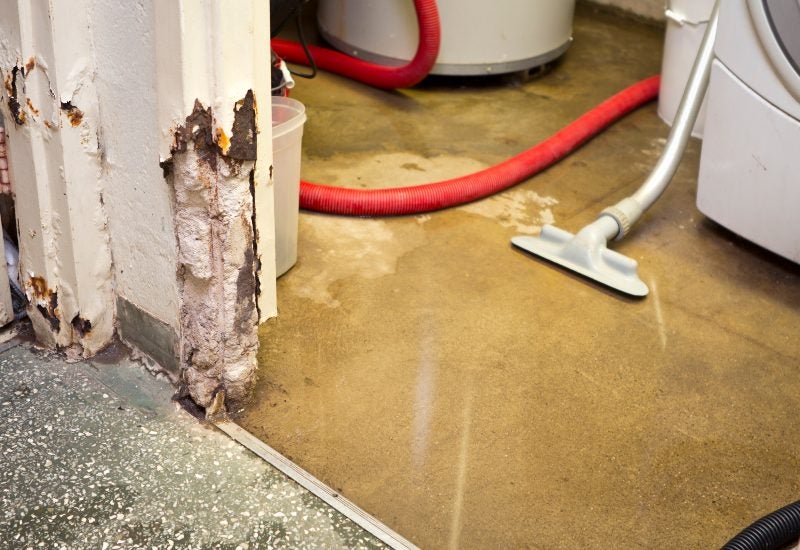
What Causes Basement Flooding?
Basements can flood for several reasons. Common causes include:
- Heavy rainfall: When intense rain over-saturates the soil around your home, the excess water may flow into your basement, especially if your property has poor drainage.
- Faulty sump pump: A sump pump is your first line of defense against basement flooding. If the pump fails due to a power outage, mechanical failure, or improper maintenance, water can quickly rise.
- Poor drainage: Clogged or improperly installed gutters and downspouts can cause water to spill over and collect near your basement, leading to floods. Soil that slopes toward your foundation rather than away from it is also an issue.
- Leaks: Cracked basement walls and floors allow rising groundwater to seep in. These leaks can form due to hydrostatic pressure from the soil outside your basement, especially after heavy rains or snow melts.
- Sewer backup: During heavy rainfall, municipal sewer systems can become overwhelmed, causing water to back up through the sewer lines. This can lead to sewage and water flowing into your basement through drains and toilets, posing serious health risks.
What to Do If Your Basement Has Flooded
Act promptly to minimize the damage from a flooded basement. Here’s what to do if your basement floods:
- Cut the power: To eliminate electrical hazards, turn off the power to the basement from your home’s main electrical panel. If you can’t access the panel safely or it’s located in the basement, call an electrician or your utility company for assistance.
- Identify where the water is coming from and stop it: If the flooding stems from a burst pipe, turn off your home’s main water supply. If the water is entering through foundation cracks, temporary sandbagging and waterproof taping may help.
- Take proper safety precautions: Wear rubber boots and gloves to safeguard against contaminated water. Remember, floodwater can contain harmful bacteria, chemicals, or sewage, so calling a professional for flooded basement cleanup is wise.
- Pump water from the basement: A sump pump can pump out large volumes of water. Direct standing water to the sump pit using a push broom, and the pump will do the rest. If you don’t have a sump pump, rent a wet-dry shop vac or pool pump. Direct the water into a drain, not your yard, where it will only further saturate the soil.
- Remove wet items: Take wet carpets, furniture, and boxes to a well-ventilated area to dry out. Sorting through these items quickly is important; some belongings may be salvageable, while others might need to be discarded due to water damage or mold growth.
- Air out and dry the basement: Good ventilation is the key to drying out a flooded basement. Use fans and dehumidifiers to circulate air and remove moisture. Only open windows if it’s dry outside to avoid introducing more humidity.
- Clean, sanitize, and deodorize: After the basement is dry, thoroughly clean and disinfect all surfaces to prevent mold. Clean nonporous surfaces with water and detergent, and sanitize with bleach to kill lingering bacteria. Porous materials may need to be professionally cleaned or discarded.
Prevent Future Basement Flooding
One instance of basement flooding is one time too many. Here’s how to fortify your basement against future water threats:
- Test your sump pump: Check the pump before the rainy season starts by pouring water into the sump pit. The pump should activate, pump out water, and turn off automatically. Consider a battery backup to ensure your sump pump works during power outages.
- Clean your gutters and downspouts: Clear leaves and debris from the gutters every spring and fall. Then, extend downspouts at least three feet away from your home to prevent water from pooling around the foundation.
- Install window well covers: Window wells can collect rainwater and snow, which then seep into your basement. Clear, domed window well covers allow light to enter while keeping out water, leaves, and debris.
- Invest in basement waterproofing: Waterproofing your basement reduces the risk of flooding. Interior waterproofing involves applying sealants, installing a drain tile system, and using a dehumidifier. Exterior waterproofing may include grading the soil, applying waterproof coatings or membranes to exterior walls, and installing pumps or French drains.
Contact Triad Basement Waterproofing in Gaithersburg, MD
At Triad Basement Waterproofing, we know nothing is more stressful than a flooded basement. Our local, family-owned business offers state-of-the-art, cost-effective solutions to keep your basement dry and safe. With over 35 years of experience, our licensed, bonded, and insured professionals ensure top-quality service with a personal touch. Plus, we stand by our work with industry-leading warranties for your peace of mind. Contact us at (301) 532-7903 for a free basement flooding repair or waterproofing estimate in Gaithersburg, MD.
-
What are the Benefits of Concrete Resurfacing?
Are your concrete surfaces looking old, worn or dirty? Whether you have concrete surfaces indoors or outdoors that are in need of refreshing, the look of dull concrete can affect the overall aesthetics of any home and irritate homeowners to no end. Many people will decide to rip out the concrete and have it completely redone from start to finish, or they will buy concrete mix and try to pour it on top of the old surface. The first option of starting fresh is not a bad idea, but it is completely unnecessary. The second option of pouring new concrete on top of old concrete is a very bad one. This doesn’t work as well as you would expect it to, because concrete does not contain bonding agents and it will not adhere to the surface beneath it. This results in crumbling and an even bigger headache for the homeowner. This is where concrete resurfacing comes in. What is concrete resurfacing? Simply put it’s a thin cement based overlay with special bonding agents that is poured over existing concrete. Here’s a quick guide that will fill you in on all the benefits of concrete resurfacing.
1. It’s Economical & Doesn’t Break Your Bank Account
In comparison to other solutions that fix worn out and cracked concrete, resurfacing is very cost efficient. The overall cost can be up to three times less than ripping up and replacingold concrete. You save money on the cost of materials and labor while still achieving the look of a brand new surface. Concrete resurfacing can also be used to repair old surfaces as well as hide damage, so you get more for your money. Whether you need a garage floor, basement floor, patio, deck or pool coated, concrete resurfacing saves you time, money and it leaves your surface looking brand new!2. It’s Easy to Apply & Saves Time
Resurfacing products are self-leveling, which means that there isn’t an extensive amount of work necessary to create a smooth and level surface. The main thing that needs to be done is to make sure that the resurfacing product is spread around the entire surface. Instead of spending time and money on trying to repair cracked concrete or ripping out an old surface and having it re-poured consider concrete resurfacing, which upgrades the look and hides any prior imperfections or cracks.3. It Allows for Different Designs & Colors for more Aesthetically Pleasing Finishes
Do you want a marble floor without paying the price of actual marble? Or maybe you prefer sandstone, brick, granite, or a specific color? The beauty of concrete resurfacing is that it can be tinted with special colorants or stamped with patterns or finishes. This allows you to customize your concrete floors and achieve the design and ambiance you’re specifically looking for without paying the price of the expensive materials.4. Increases Resilience to Future Wear & Tear
The materials used in concrete resurfacing are very durable and some can even be stain resistant. Triad’s heavy-duty epoxy-based systems not only upgrade the look of the floor you are resurfacing, but they also increase resiliency to stains, tire marks and hide minor imperfections. One of the best things about concrete resurfacing is that your new surface has the potential to last much longer than your existing concrete surface did.5. It Can Increase the Value of Your Home
The benefits of concrete resurfacing go above and beyond the basic idea of upgrading a floor. It becomes an investment for the home, because it fixes cracked, damaged and worn out floors to make them look brand new while adding a customized design aspect, which in turn increases the value of the home. Concrete resurfacing is also often sealed and has the potential to last longer since it protects from daily wear and tear. You can even add non-slip coatings to your new floor so that it is safe to walk on regardless of how wet it gets.If you are considering fixing or replacing your concrete floors don’t rush into any final decisions before thoroughly researching all your options. Maybe tearing up your old concrete really is the best option, but chances are that concrete resurfacing will be able to repair and completely renovate your surfaces efficiently at a lower price. Triad Waterproofing offers a variety of colors and concrete coatings to choose from for your resurfacing needs and we also offer waterproofing for a completely dry and warm home. Contact us for a free estimate or for more information and check out our website to familiarize yourself with our other services!
-
How a Leaky Basement Can Ruin Your Home
How a Leaky Basement Can Ruin Your Home
At Triad Basement Waterproofing, we know a leaky basement is not only inconvenient but can cause significant damage to your home. It can affect everything from cosmetic damage to extensive structural issues, along with health risks from mold and mildew growth. Today we’ll explore what a basement leak is, different types of leaks, the common causes, and how to address and prevent them.
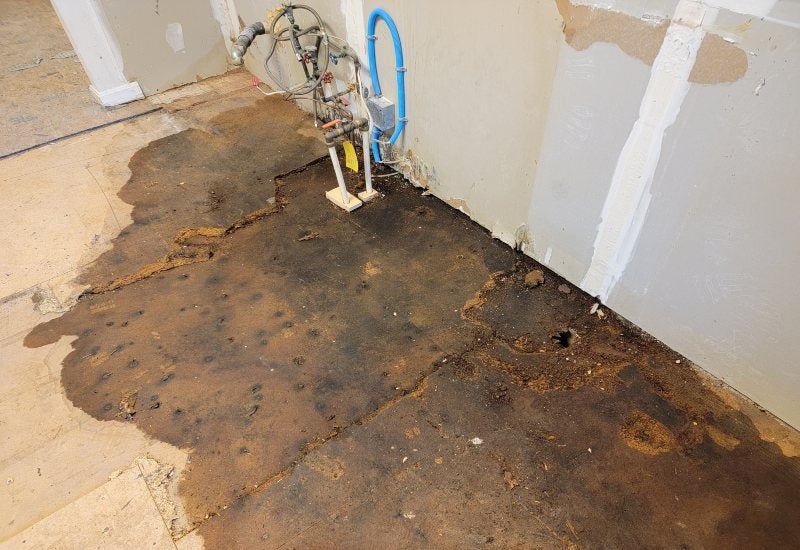
What is a Basement Leak?
A basement leak is any unwanted entry of water into a basement space. Water can enter through cracks in the foundation, joints between basement walls, around windows and doors, or through the floor. Basement leaks vary in severity from occasional dampness to severe flooding during heavy rainfall.
Why Are Basement Leaks Problematic?
Water intrusion can lead to a host of problems, including:
- Structural Damage: Continuous water exposure can weaken concrete and lead to significant foundation damage, which is costly to repair.
- Mold Growth: Damp conditions are perfect for mold and mildew, which can affect indoor air quality and lead to health issues like allergies or respiratory problems.
- Damage to Belongings: Water damage can ruin furniture, electronics, documents, and other valuables stored in basements.
- Decreased Property Value: Homes with a history of basement leaks are often less appealing to buyers, reducing the property’s market value.
What Are the Different Types of Basement Leaks?
Basement leaks come in various forms, and understanding these types helps you assess the severity of the problem.
Common Basement Leaks
The most common type of basement leak occurs due to hydrostatic pressure, which is caused by the accumulation of groundwater around the foundation. As the pressure builds, water finds its way through small cracks, gaps, and porous materials. These leaks can appear as damp spots, efflorescence (a white, powdery deposit), or pooling water on the basement floor.
Uncommon but Serious Basement Leaks
While less common, more serious leaks result from significant structural failures, such as bowing or cracked walls, major foundation shifts, or faulty construction. These leaks can lead to extensive damage and require professional intervention. If your basement walls appear to be bowing or showing large cracks, it’s crucial to seek expert advice.
Causes Of Basement Water Leaks
Various factors contribute to basement leaks. Here are some of the most common causes:
Hydrostatic Pressure
As water accumulates in the soil surrounding the foundation, it creates hydrostatic pressure. This pressure pushes against basement walls and floors, leading to leaks through any available openings.
Window Well Issues
Window wells collect rainwater, but if they’re clogged or not properly drained, water can seep into the basement around the window frames. This type of leak is usually localized but can be problematic during heavy rain.
Expansive Soil
Expansive soils, like clay, expand when wet and contract when dry. This constant expansion and contraction can put undue pressure on basement walls, causing cracks and leaks.
Downspouts and Clogged Gutters
Gutters and downspouts are designed to direct water away from the foundation. When they are clogged or improperly placed, water can overflow and saturate the ground near the basement, leading to leaks.
How To Fix Water Leaking into Basement After Heavy Rain?
If your basement is leaking after heavy rain, here’s a step-by-step guide to fix the problem:
- Determine The Source of Leak
Inspect your basement thoroughly to identify the source of the leak. Look for cracks in the walls or floors, gaps around pipes, or signs of water pooling. If the source isn’t immediately apparent, consider consulting a professional.
- Check And Ensure Proper Grading
The ground around your home should slope away from the foundation to prevent water from pooling near the basement walls. If the grading is incorrect, regrade the area to ensure proper drainage.
- Clean Clogged Gutters and Downspouts
Clogged gutters and downspouts can cause water to overflow and saturate the ground near the foundation. Regularly clean your gutters and ensure downspouts are directing water at least four to six feet away from your home.
- Install Proper Window Wells
Window wells should have a functioning drainage system and be clear of debris. Ensure they are properly installed and consider adding covers to prevent leaves and other debris from accumulating.
How To Prevent Basement Water Leakage in Future?
Prevention can help you avoid basement leaks. Here’s what you can do to stop the problem before it starts:
Waterproof Your Basement
Apply a waterproof coating to the interior walls of your basement. This creates a barrier that prevents water from seeping through. Exterior waterproofing can also be effective, but it is typically more expensive.
Repair Foundation Cracks
Fill in any foundation cracks with hydraulic cement or a similar waterproof compound. This prevents water from entering through these openings.
Add Extensions to Downspouts
Ensure downspouts extend at least four to six feet away from the house to reduce water accumulation near the foundation. This simple step can significantly decrease the risk of basement leaks.
Install a Sump Pump
If your basement is prone to flooding, consider installing a sump pump. This device pumps water out of the basement, preventing flooding during heavy rain or other high-water events.
With proper maintenance and preventive measures, you can keep your basement dry and protect your home from the costly damage that basement leaks can cause. Regular inspections and timely repairs are key to ensuring your home remains a safe and comfortable environment.
Call Triad Basement Waterproofing
For over 30 years, Triad Basement Waterproofing has been solving moisture problems in basements across Washington D.C., Virginia, and Maryland. Our professionals are skilled at finding and fixing water leakage issues before they can grow large enough to cause problems with the structural integrity of your home. We have developed state-of-the-art solutions for basement water leakage and structural support. We also remove mold and mildew when it finds its way into your home and craft drainage solutions to make sure these issues don’t happen again. Call us now at (301) 532-7903 or visit our website at Triad Basement Waterproofing to schedule your free consultation.
